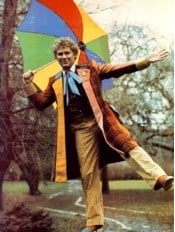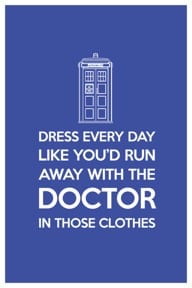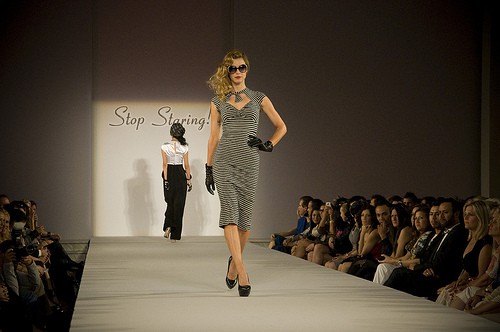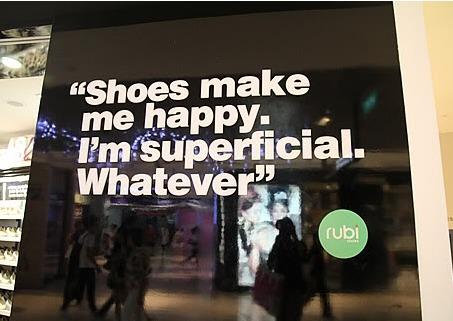Doctor Who shaped my sartorial style.
Each incarnation1 of the time traveling alien Time Lord always wears the same set of distinctive clothes. With every regeneration comes not only a new face, but a new wardrobe. I laughed watching the fourth Doctor pick out his wardrobe about 10 minutes into the Robot. I can think of at least three incarnations of the Doctor who stole their clothes from a hospital.

“The yellow trousers, vivid enough in themselves, were positively sober compared to a multi-coloured coat that might have made Joseph himself feel a pang of envy.” From The Mysterious Planet by Terrance Dicks
Some wardrobes were more successful than others. Tom Baker’s long scarf became iconic and recognizable even to non-Doctor Who fans. On the other hand, Colin Baker’s coat was described as “every headache I’ve ever had” in Big Finish’s audio The First Sontarans. I’m looking forward to the Splendid Chaps podcast, which promises to cover the huge topic of the Doctor and clothing in June’s episode.
Even the Doctor critiques his own fashion sense. The first Doctor describes his second and third incarnations as, “a clown and a dandy” in The Three Doctors. In Time Crash, the tenth Doctor points to the (in)famous stick of celery pinned to the fifth incarnation’s lapel, praising his brave choice for pulling off a decorative vegetable. In Amy’s Choice, the Dream Lord (the Doctor’s alien psychic pollen induced sub-conscious) insults the Doctor’s “tawdry quirks” such as his “cockamamie hair (and) clothes designed by a first-year fashion student.” And in Journey to the Centre of the TARDIS, the Doctor describes his fellow Time Lords as a “smart bunch…no dress sense, dreadful hats, but smart.”
After novelizing over 60 stories, Terrance Dicks found a concise description for each incarnation of the Doctor in his Target novels. See if you can guess which Doctor Terrance describes (click on the link to see if you’re right).
“…flamboyantly dressed in a velvet smoking-jacket and ruffled shirt…”
“… a lined, white-haired old man with a face full of dignity, power, and a touch of cranky bad temper.”
“…a middle-sized, middle-aged man in a shabby old frock coat and rather baggy check trousers.”
Despite traveling to different planets and different times in different incarnations, the Doctor always manages to fit in, whatever clothes he is wearing. He never allows the culture he’s visiting to define him. Wearing his cricketer’s outfit, the fifth Doctor is just as comfortable meeting people in 17th century England as he is on future alien worlds. People tended to dismiss the hobo-like second Doctor until they encounter his keen intelligence and strong will. We tend to believe that the “clothes make the man (or woman),” but the Doctor seems to make the clothes.
***

The Fifth Doctor sporting a decorative vegetable.
Whether he’s shabbily or gaudily dressed, the essence of the Doctor comes through despite what he’s wearing. Doctor Who teaches that appearances can be deceptive so you can’t judge a person by what they are (or are not) wearing. The Doctor seems to transcend his clothing in a way we cannot.
Of course, we don’t travel through time and space. With the exceptions of some exotic foreign travel, most of us find ourselves locked in one particular culture… and what we wear matters a lot. Regular TJP readers might remember the always-dapper Vinny Marchionni’s piece on how good clothes inspires confidence both in the sporting world and in the larger society.
Even more than confidence, wearing certain clothes can even influence how we process data! A recent study on “embodied cognition” shows that wearing a white coat you believe belongs to a doctor increases your ability to pay attention whereas wearing a painter’s white coat does not.
And we all recognize how others will perceive us based on what we’re wearing, which is why we spend a lot of time selecting the clothes we’ll wear to obtain that “look” we desire. As a Jesuit, I discern which clothes I’ll wear each day: a black clerical shirt when I’m representing the Church or a T-shirt and rubber waders when I’m a biologist collecting snail parasites. Such discernment occurs in other religious orders as well. I’ve heard that when a Dominican is sent to buy beer for his community, he’s told to “dress like a Jesuit.” There are many “looks” out there, each saying something slightly different about whom we are or want to be. But there exists a shadow side in the fashion world. Consider some of these fashion “statements” found on pinterest:
On one hand, these fashion memes might be harmless hyperbole. On the other hand, I think I know some people who live their lives according to these memes. If what we wear reflects who we are and what we value, then anyone who takes these statements seriously needs to re-evaluate their priorities. Trying to look good is fine, but we need to ask why we want to look good… and at what we’re willing to sacrifice to get there. Again, Vinny does a good job finding the balance between being confident and authentic without being superficial in his side-by-side comparison of two music videos. We need to be careful that our own “look” doesn’t become a song with the repeated refrain:
“I only care about looks.”
“I only care about money.”
“I only care about me.”
Obviously, we can take our concern for fashion too far. We can obsess over how we look at the expense of caring about more important things. Does it seem right that a guy cares more about the brand of boxers he’s wearing than the fact that malaria killed over 600,000 people in 2010? Should a woman care more about cramming her foot into a poorly fitting (but highly fashionable) high heel shoe than she does about the fact that 6.9 million children under the age of five died in 2011? Perspective helps.
When I worked in St. Procopius’ clothing room in the predominately Hispanic Pilsen neighborhood of Chicago, I saw how much clothing people donated. We sorted hundreds of garbage bags full of clothes on a regular basis. Some of the clothes still had their price tags attached! Were these people exceptionally generous in charitable giving?
Elizabeth Cline cites a 2010 national survey in ShopSmart magazine which reports that one in four American women own seven pairs of jeans but only four of them are regularly worn. She explains how the fashion industry produces “disposable” clothing that accumulates in our increasingly larger closets before we “donate” them to charity. These charities, overwhelmed with clothes, send them to “rag-cut” rooms where they are recycled or sold overseas. After viewing such a room, Cline writes, “I saw tags for Old Navy, Sean Jean, and Diesel peeking out of the bales, as well as slivers of denim, knits in bright maroons and bold stripes, and the smooth surfaces of Windbreakers. Smashed together like this, stripped of its symbolic meaning, stacked up like bulk dog food, I was reminded that clothing is ultimately fiber that comes from resources and results in horrifying volumes of waste.”
Not only does this constant production of rarely worn clothes strain our environment, using up valuable resources, but also consumer demand for cheap clothes impacts manufacturers and their workers. Forced to maximize profits, cut costs, and meet consumer demand, manufacturers fail to provide safe working conditions for their workers.

More fashion advice
We saw this with last month’s collapse of the Dhaka garment factory roof in Bangladesh that killed over 900 people, many of them poor garment factory workers. When workers try to protest they are often met with violence that can be fatal. A pregnant Cambodian woman lost her baby when police stunned her with a cattle prod during a protest over low wages at a Nike factory. Pope Francis recently spoke out against the dangers of valuing people over profits and called for more corporate responsibility.
We can help to change the fashion industrial complex and its associated injustices. Like the Doctor, we can refuse to be slaves to fashion. We can take advantage of the “disposable” clothing industry by purchasing more of our clothes from thrift stores (thank you Macklemore for popularizing this option with your clever Thrift Store song!) We can also wear our clothes until they are no longer functional instead of until they are no longer fashionable. We can insist on wearing clothing that says something different…something about who we are who we want to be.
We can reject those fashion statements that embrace an overly consumerist society and come up with our own statements by allowing the “every headache you ever had” fashion advice of a Time Lord to inspire us. How can we dress to make meaningful fashion statements such as, “I care about the poor” or “I care about the environment”?
— — // — —






